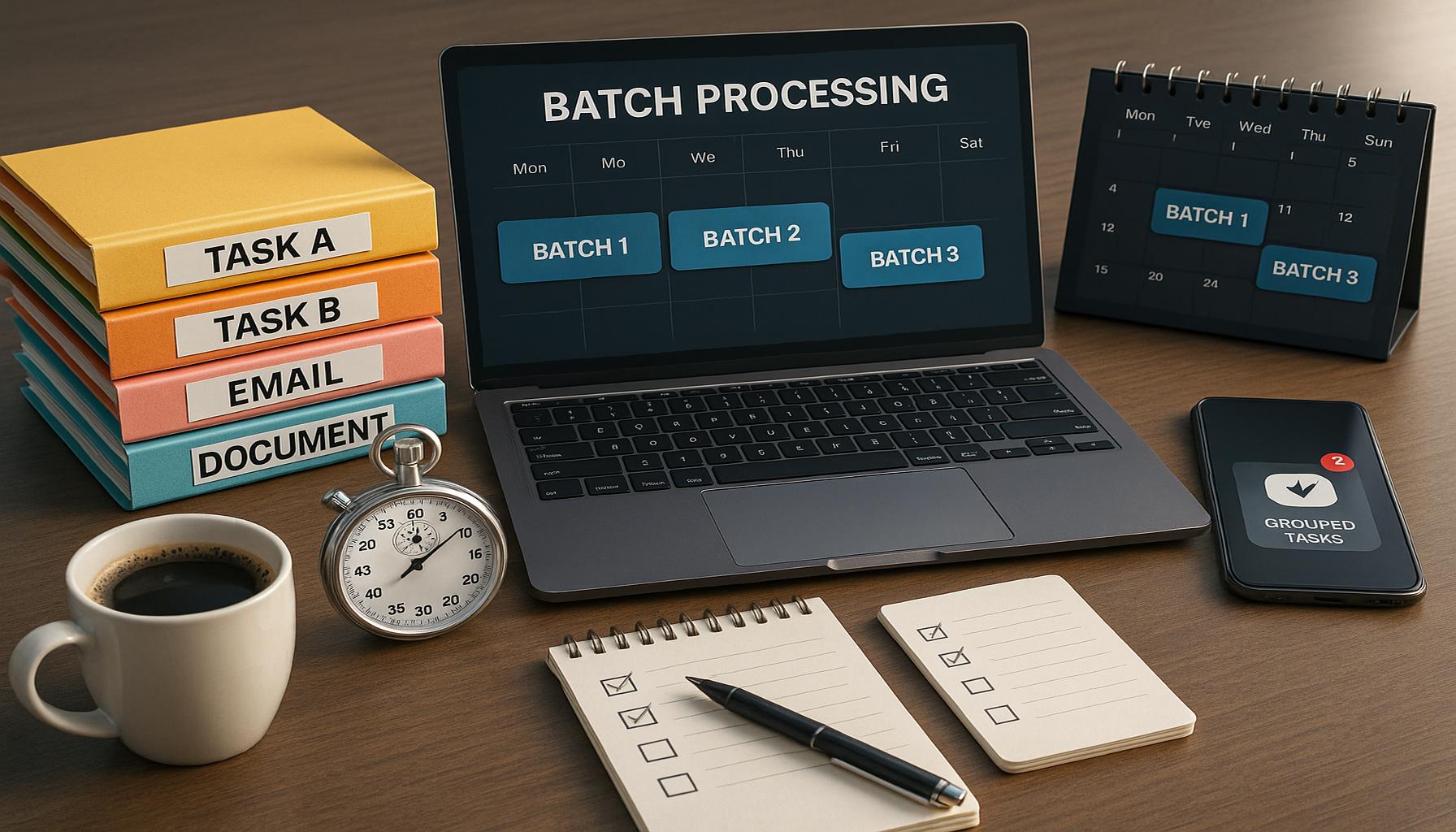Batch Processing: Grouping Similar Tasks to Save Time

Efficiency in Task Management
In today’s fast-paced world, achieving maximum efficiency in both personal and professional arenas is crucial. One effective approach to attaining this goal is through batch processing, a method that allows individuals and organizations to group similar tasks for streamlined execution. By employing this strategy, not only can time be saved, but productivity can also be significantly enhanced.
Benefits of Batch Processing
Consider the following benefits of batch processing:
- Reduced Switching Costs: Frequent transitions between different tasks can lead to wasted time. By batching similar activities together, individuals eliminate the need to constantly reorient themselves, minimizing this downtime.
- Increased Focus: When working on a single type of task for an extended period, concentration tends to improve. This can lead to higher quality outputs, as attention to detail is heightened when distractions are minimized.
- Better Resource Management: Utilizing tools and technology effectively becomes easier with batch processing. For instance, software applications that automate repetitive tasks can be used in a single session for all similar tasks, thus optimizing time and effort.
Real-World Applications
This methodology has wide-ranging applications across various sectors. For example, in software development, programmers might set aside time to debug code in batches rather than toggling between coding and testing continuously. In the realm of marketing campaigns, a digital marketer could schedule a day solely focused on creating advertisements, thus enabling them to generate multiple creative versions before moving on to analysis.
Consider the case of a graphic designer. Instead of sporadically creating social media posts throughout the week, they might dedicate a couple of hours on a specific day to produce all scheduled posts. This not only allows for a cohesive visual strategy but also enhances creativity due to sustained focus on the design work.
Implementing Batch Processing
Diving deeper into batch processing can reveal specific strategies tailored to individual needs. For students, this could mean setting aside uninterrupted blocks of time to complete similar homework assignments, thereby fostering a better understanding of the subject matter. For businesses seeking to enhance workflow, establishing dedicated time slots for processing email communications or meeting notes can lead to significant improvements in time management and output efficiency.

This practice encourages individuals across various fields to explore and implement batching techniques. By refining how tasks are grouped and executed, the potential for remarkable productivity gains and enhanced time management becomes a reality.
Maximizing Productivity Through Batch Processing
Batch processing is not just a buzzword; it is a strategic approach that can revolutionize how tasks are approached and completed. By grouping similar tasks together, individuals can significantly enhance their productivity and manage their time more effectively. The practice essentially revolves around the principle of tackling one type of task in a designated block of uninterrupted time, leading to higher efficiency and reduced mental fatigue.
Identifying Tasks for Batching
The first step in implementing batch processing involves identifying tasks that can be categorized together. This can vary widely depending on the individual’s role, profession, or daily responsibilities. Here are some common categories that lend themselves well to batching:
- Administrative Tasks: Emails, scheduling meetings, and filing paperwork can all be completed in one setting, eliminating the constant interruption of switching between them.
- Creative Work: Writers, artists, and designers can set aside dedicated time blocks for brainstorming, sketching, or drafting, allowing for a deeper dive into their creative processes.
- Research and Analysis: Researchers can concentrate their efforts to gather data, analyze results, and compile reports, enhancing both focus and retention.
- Communications: Business professionals can batch phone calls and follow-ups, ensuring that their communication efforts are efficient and not fragmented throughout the day.
Psychological Benefits of Batch Processing
Engaging in batch processing also provides psychological advantages. The mental clarity achieved by concentrating on similar tasks helps in reducing cognitive load. When individuals focus on one type of task, they are less likely to feel overwhelmed by shifting gears frequently. Studies have shown that minimizing task-switching can lead to a significant decrease in stress levels and an increase in job satisfaction.
Batch Processing in the Digital Age
As our world becomes increasingly digital, the opportunities to leverage batch processing multiply. Modern productivity tools and applications allow for not only automation but also smoother transitions between tasks. For example, a project manager can utilize software to set timelines for specific tasks, allowing all relevant team members to concentrate on similar activities simultaneously. This synergy can lead to quicker project completion and free up time for strategic planning and innovation.
Incorporating batch processing into one’s daily routine is not merely about efficiency; it’s about creating a culture of productivity. Whether in personal, academic, or professional settings, the practice of grouping tasks allows individuals to unlock their full potential, leading to enhanced outcomes and greater satisfaction in their efforts.
| Advantage | Details |
|---|---|
| Increased Efficiency | Batch processing allows for completing similar tasks simultaneously, minimizing the time spent on transitions and improving overall workflow. |
| Enhanced Focus | Grouping tasks reduces mental fatigue and interruptions, allowing for deeper concentration and higher quality outputs. |
The concept of batch processing not only aids in enhancing productivity but also transforms how individuals manage their day-to-day tasks. By organizing similar activities together, individuals can experience significant time savings. Research indicates that frequent task switching can lead to a vast decrease in efficiency, making batching an effective strategy not just for businesses but also for personal productivity. As more people explore the advantages of implementing batch processing, they find that their time management improves, reducing stress and leading to increased satisfaction in their work. This structured approach to completing tasks is proving to be indispensable in our fast-paced, digitally driven world, encouraging individuals to reevaluate their daily habits and optimize their workflow.
Implementing Batch Processing in Everyday Life
While the concept of batch processing may seem straightforward, successfully incorporating it into daily routines requires a systematic approach. Establishing a tangible workflow can significantly enhance the effectiveness of this method. Here are several strategies that individuals and organizations can utilize to implement batch processing effectively:
Time Blocking Techniques
One practical method is the time blocking technique, which involves scheduling dedicated time slots for specific tasks. For instance, setting aside two hours every morning solely for email correspondence can limit distractions from incoming messages throughout the day. This approach not only creates a predictable routine but also helps in maintaining a focused mindset. Tools like Google Calendar and Asana can aid in visually organizing these blocks, allowing for greater clarity in planning.
The Pomodoro Technique
Another valuable method is the Pomodoro Technique, which combines batching with short breaks. This time management strategy encourages individuals to work for 25 minutes on a single task and then take a 5-minute break. After completing four cycles, a longer break of 15 to 30 minutes is recommended. This rhythm of focused work followed by rest not only reinforces productivity but also enhances mental endurance, making batch processing more sustainable over longer periods.
Eliminating Distractions
To maximize the effectiveness of batch processing, it’s essential to create an environment conducive to deep work. Eliminating distractions—such as turning off notifications on devices or utilizing apps like Freedom or Cold Turkey—can significantly increase focus. Designating a specific workspace that promotes minimal interruptions is equally important. By consciously curating one’s environment, individuals can further streamline their batch processing efforts.
Real-Life Applications of Batch Processing
Batch processing is not limited to workplace tasks; it can also be applied in personal life. Consider meal prepping as an excellent example of this approach. By allocating a few hours each week to prepare meals in bulk, individuals not only save cooking time on busy weekdays but also make healthier choices by having ready-to-eat options available. Numerous food bloggers and fitness enthusiasts advocate for batch cooking, illustrating its practicality in everyday nutrition management.
Furthermore, batching household chores can lead to a smoother and more organized home life. For instance, setting a specific day of the week for laundry, grocery shopping, and cleaning can prevent these tasks from becoming overwhelming when tackled individually. By designating time for these essential activities, families can spend more quality time together and reduce the stress associated with ongoing responsibilities.
Measuring the Impact
To truly appreciate the benefits of batch processing, it is vital to measure its impact. Keeping track of completed tasks and evaluating the time taken to accomplish goals can provide insight into the effectiveness of this approach. By analyzing results, individuals or teams can refine their batching strategies and identify areas for improvement. Data analytics tools or simple spreadsheets can help visualize progress and hold individuals accountable in their quest for productivity.
As the world continues to evolve, the practice of batch processing serves as a powerful method to adapt and thrive. Whether in professional settings or personal life, understanding how to group similar tasks effectively can lead to significant time savings, improved focus, and ultimately, a more balanced and fulfilling lifestyle.
Conclusion
In an increasingly fast-paced world, batch processing emerges as a strategic approach that empowers individuals and organizations to optimize their productivity and reclaim valuable time. By grouping similar tasks together, this method not only minimizes the cognitive load associated with multitasking but also enhances focus and efficiency, ultimately fostering a more balanced lifestyle. Through techniques like time blocking and the Pomodoro Technique, professionals can establish structured workflows that reduce distractions and enable sustained attention on critical tasks.
Moreover, the application of batch processing transcends professional environments, offering solutions for everyday life, from meal preparation to household management. This adaptability makes it a valuable tool for anyone seeking to streamline their responsibilities and improve overall well-being. As individuals begin to measure the impact of their efforts, they can adjust and refine their strategies, ensuring continuous improvement and heightened effectiveness. The data-driven approach to evaluating results can provide insights that enhance productivity strategies across the board.
In summary, embracing batch processing is not merely about completing tasks more efficiently; it is about transforming our relationship with time itself. In a world that often feels overwhelmingly busy, finding ways to save time can lead to a richer, more fulfilling life. As you explore and implement batch processing in your own routines, you may uncover newfound freedom and the potential for growth in various aspects of your life. The journey toward effective time management starts with this simple yet powerful shift in approach—one where similar tasks are tackled together, paving the way for greater success and satisfaction.
Related posts:
Batch Processing: Grouping Similar Tasks to Save Time
Batch Processing: Streamlining Your Workflow
Leveraging Technology: Apps and Tools for Better Time Management
Mindfulness and Time Management: Enhancing Productivity through Presence
How the Pomodoro Technique Can Boost Your Productivity in 2023
The Two-Minute Rule: Quick Wins for Increased Efficiency

Linda Carter is a writer and time management specialist who helps professionals optimize their schedules and maximize productivity. With extensive experience in efficiency techniques and work-life balance strategies, she shares practical time management methods on our platform. Her goal is to empower readers with actionable systems to take control of their time, reduce stress, and achieve both professional and personal goals.